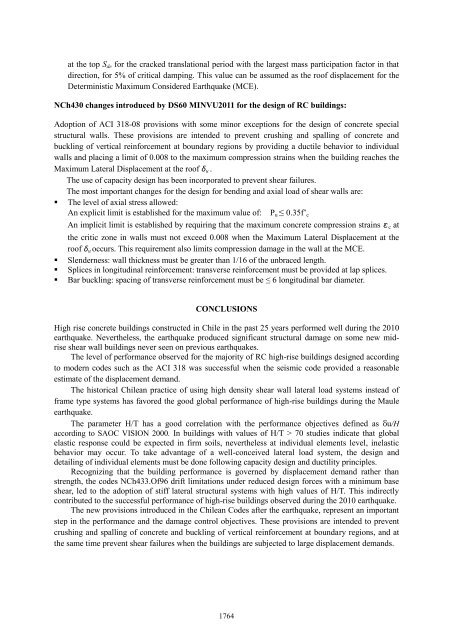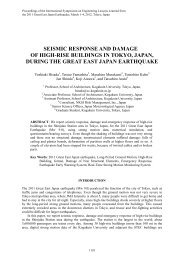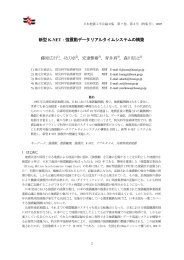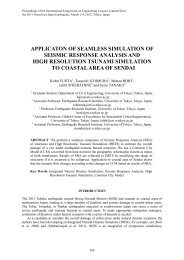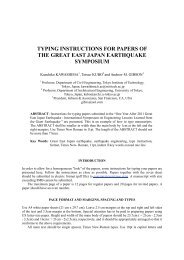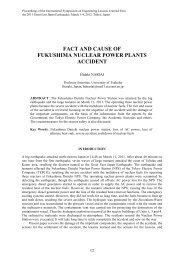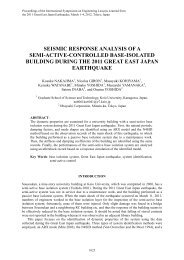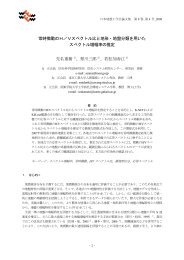Performance of High Rise Buildings under the February 27th 2010 ...
Performance of High Rise Buildings under the February 27th 2010 ...
Performance of High Rise Buildings under the February 27th 2010 ...
Create successful ePaper yourself
Turn your PDF publications into a flip-book with our unique Google optimized e-Paper software.
at <strong>the</strong> top S de for <strong>the</strong> cracked translational period with <strong>the</strong> largest mass participation factor in thatdirection, for 5% <strong>of</strong> critical damping. This value can be assumed as <strong>the</strong> ro<strong>of</strong> displacement for <strong>the</strong>Deterministic Maximum Considered Earthquake (MCE).NCh430 changes introduced by DS60 MINVU2011 for <strong>the</strong> design <strong>of</strong> RC buildings:Adoption <strong>of</strong> ACI 318-08 provisions with some minor exceptions for <strong>the</strong> design <strong>of</strong> concrete specialstructural walls. These provisions are intended to prevent crushing and spalling <strong>of</strong> concrete andbuckling <strong>of</strong> vertical reinforcement at boundary regions by providing a ductile behavior to individualwalls and placing a limit <strong>of</strong> 0.008 to <strong>the</strong> maximum compression strains when <strong>the</strong> building reaches <strong>the</strong>Maximum Lateral Displacement at <strong>the</strong> ro<strong>of</strong> δ u .The use <strong>of</strong> capacity design has been incorporated to prevent shear failures.The most important changes for <strong>the</strong> design for bending and axial load <strong>of</strong> shear walls are:• The level <strong>of</strong> axial stress allowed:An explicit limit is established for <strong>the</strong> maximum value <strong>of</strong>: P u ≤ 0.35f’ cAn implicit limit is established by requiring that <strong>the</strong> maximum concrete compression strains e c at<strong>the</strong> critic zone in walls must not exceed 0.008 when <strong>the</strong> Maximum Lateral Displacement at <strong>the</strong>ro<strong>of</strong> δ u occurs. This requirement also limits compression damage in <strong>the</strong> wall at <strong>the</strong> MCE.• Slenderness: wall thickness must be greater than 1/16 <strong>of</strong> <strong>the</strong> unbraced length.• Splices in longitudinal reinforcement: transverse reinforcement must be provided at lap splices.• Bar buckling: spacing <strong>of</strong> transverse reinforcement must be ≤ 6 longitudinal bar diameter.CONCLUSIONS<strong>High</strong> rise concrete buildings constructed in Chile in <strong>the</strong> past 25 years performed well during <strong>the</strong> <strong>2010</strong>earthquake. Never<strong>the</strong>less, <strong>the</strong> earthquake produced significant structural damage on some new midriseshear wall buildings never seen on previous earthquakes.The level <strong>of</strong> performance observed for <strong>the</strong> majority <strong>of</strong> RC high-rise buildings designed accordingto modern codes such as <strong>the</strong> ACI 318 was successful when <strong>the</strong> seismic code provided a reasonableestimate <strong>of</strong> <strong>the</strong> displacement demand.The historical Chilean practice <strong>of</strong> using high density shear wall lateral load systems instead <strong>of</strong>frame type systems has favored <strong>the</strong> good global performance <strong>of</strong> high-rise buildings during <strong>the</strong> Mauleearthquake.The parameter H/T has a good correlation with <strong>the</strong> performance objectives defined as δu/Haccording to SAOC VISION 2000. In buildings with values <strong>of</strong> H/T > 70 studies indicate that globalelastic response could be expected in firm soils, never<strong>the</strong>less at individual elements level, inelasticbehavior may occur. To take advantage <strong>of</strong> a well-conceived lateral load system, <strong>the</strong> design anddetailing <strong>of</strong> individual elements must be done following capacity design and ductility principles.Recognizing that <strong>the</strong> building performance is governed by displacement demand ra<strong>the</strong>r thanstrength, <strong>the</strong> codes NCh433.Of96 drift limitations <strong>under</strong> reduced design forces with a minimum baseshear, led to <strong>the</strong> adoption <strong>of</strong> stiff lateral structural systems with high values <strong>of</strong> H/T. This indirectlycontributed to <strong>the</strong> successful performance <strong>of</strong> high-rise buildings observed during <strong>the</strong> <strong>2010</strong> earthquake.The new provisions introduced in <strong>the</strong> Chilean Codes after <strong>the</strong> earthquake, represent an importantstep in <strong>the</strong> performance and <strong>the</strong> damage control objectives. These provisions are intended to preventcrushing and spalling <strong>of</strong> concrete and buckling <strong>of</strong> vertical reinforcement at boundary regions, and at<strong>the</strong> same time prevent shear failures when <strong>the</strong> buildings are subjected to large displacement demands.1764


